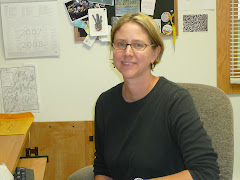We read an article discussing ant-caterpillar-plant symbioses. A few students before class told me how much they liked the article this time (I am not sure they really enjoyed the last one!); so I was fairly confident that the students would enjoy talking to each other about the paper.
At the beginning of class I arranged the students into groups of 4 and asked them to assign a recorder and a reporter. Immediately a very active and engaged atmosphere began. Students were bent over their papers in groups speaking rapidly in both Slovene and English (when I came around), and referring to their paper summaries. I walked around the class helping with some explanations of the questions, and encouraging students as needed. But I must say that because the students had already experienced the group work – they had no shyness and jumped right in!
After about half an hour of group discussion, we came back together as a class and I asked each group to report their answers for a question. This dissolved nicely into a less formal discussion of the paper and its findings and their general understanding of the evolution of these interesting symbiotic relationships. Overall, I think that this was a success and hopefully a fun experience for the students.
Student Groups immersed in Discussion


 (Neuroptera Myrmeleontidae), was found at frequent sites along the road. To find the second ant lion species, Myrmeleon formicarius, my son, Caleb, Dušan, and I hiked along a beautiful path with huge beech trees and wonderful views of the valley. The larvae were found on a hillside about 20 minutes along the path.
(Neuroptera Myrmeleontidae), was found at frequent sites along the road. To find the second ant lion species, Myrmeleon formicarius, my son, Caleb, Dušan, and I hiked along a beautiful path with huge beech trees and wonderful views of the valley. The larvae were found on a hillside about 20 minutes along the path. 




